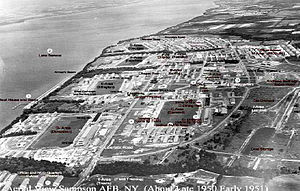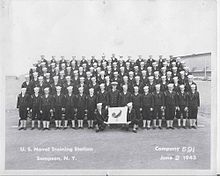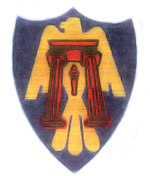346:, California to accommodate new enlistees. The mission of Sampson AFB was to provide formal basic training for all male and female enlisted personnel not having sufficient previous military training; to establish and operate such assembly, processing and separation station as specifically directed; to provide a comprehensive counseling program for Basic Indoctrinee personnel in order that these airmen may be most effectively assigned in accordance with Air Force requirements; and to maintain training programs for accomplishing rehabilitation of garrison prisoners. The first trainees arrived on 1 Feb 1951. The base employed about 700 civilians and had 600 permanent party troops.
28:
350:
Sampson and Parks AFB for BMT, Shortly thereafter, ATC increased basic military training from seven weeks to eight. In July 1952 the Air Staff approved a 12-week course, which ATC implemented on 1 August at
Lackland and Parks and on 1 September at Sampson. However, after only two months, the Air Staff decided that the course should be shortened, and ATC developed an 11-week program to begin in January 1953. The host organization at Sampson was redesigned as the 3650th Military Training Wing, Air Training Command, in March 1953.
316:
154:
58:
184:
300:
33:
308:
416:
it burned down in 1989. In 1960 the State of New York purchased and assumed ownership of all tracts of land on the former base at a cost of $ 500,000. Most of the buildings were dismantled and materials were sold for re-usage throughout the Finger Lakes Region. One of the Drill Halls is now in use at
Middlebury College, Vermont. Major roads and identification signs remain today on the base.
423:. The duration of the civilian use of the Seneca airfield has not been determined, but it was evidently a brief period as the Army returned it to military control during the Vietnam War and renamed it Seneca Army Airfield. It was used for security at Seneca Army Depot, with the former fire station being used as hangars for the helicopters supporting depot security. Air Force
668:
161:
606:
291:, which used the buildings as warehouses and granaries. More than 110,000 bushels of excess wheat and 15,000 sacks of excess beans were stored at Sampson. In addition, the State of New York, realizing the scenic location of the former Naval Station, appropriated $ 50,000 for the creation of a state park at Sampson.
473:
is being developed into an emergency services training site. Just inside the gate is a brand new State Police barracks, and sharing the building is a police & fire training center. A new fire training tower was built southeast of the control tower, and the 7,000-foot runway is used for high-speed
415:
The former hospital area was operated as a state school. In 1971, the State of New York closed the School due to budget cuts and while empty, a fire destroyed most of the main hospital complex. Contaminated by asbestos, the site was cleaned and is still owned by the
Department of Mental Hygiene when
349:
During the years before the Korean War, basic military training had lasted anywhere from 4 to 13 weeks. In the rush to flow recruits through the training system and into the theater of conflict, ATC reduced the course to seven weeks in 1950 and then to two weeks in
January 1951. With the opening of
272:
in 1946. Most of the facility was taken over by New York State, which planned to establish a two-year junior community college on the facility, keeping most of the buildings and using it as a campus. The USN Hospital was eventually taken over by the state of New York, renaming it the
Willard State
369:
With the end of the Korean War and cutbacks in the military budget afterwards, Air
Training Command discontinued its basic training school at Sampson AFB on 1 July 1956. Shortly thereafter, ATC discontinued Sampson's 3650th Military Training Wing. By the time it was closed, over 300,000 airmen
249:, New York. Construction of the facility took 270 days to complete. Along with the training station, a 1,500-bed hospital was constructed. The mission of USNTS Sampson was Naval basic training for large numbers of new recruits. During the war, over 411,000 recruits were trained at the station
353:
The Air Force also built a runway and other facilities at
Sampson and converted the base to its needs. By 1953, a single paved 5,000 foot north–south runway (Rwwy 17/35) was completed and a control tower, fire station and aircraft parking ramp was built on the west side, with
327:, the United States Air Force took interest in the former Naval Station for use as a Basic Military Training (BMT) Base. Custody of the most of the property of the training center was transferred to the Air Force in 1950, and the Air Force named the facility
477:
The majority of the former Air Force base today is now abandoned. While the streets exist, most of the land is vacant as a result of the 1960 New York State facilities removal. However, a large cluster of buildings in the northeast part of the base
693:
610:
342:, Texas was overflowing. During the first two weeks of 1951, the population at Lackland AFB jumped from 36,513 to over 70,000 people. In addition, a third BMT center was established at
703:
698:
713:
708:
688:
509:
remain in a very deteriorated condition, some having roofs, some not. The main gate on
Sampson State Park Road, west of the intersection with NY Highway 96A
319:
Wartime graduation of new airmen, BMT Flight 1513 3691 BMTS June 1952. Many of these airmen probably served in the Korean War after technical training.
643:
288:
334:
The Air Force spent about $ 6 million on renovations and beginning in
February 1951 started training what would be 16,000 Air Force recruits.
645:
338:
established the 3650th
Indoctrination (later Military Training) Wing to manage the base and conduct Basic Training, as its major facility at
73:
284:) Sampson College operated from September 1946 to June 1949 and had matriculated 7,500 students of which 950 received two-year degrees.
577:
is currently located in the building which was formerly the old stockade/brig. The displays are quite extensive, including a restored
375:
174:
153:
277:
445:
549:
512:
481:
213:
27:
658:
434:
The Seneca Army Depot was identified for closure in 1995 as part of the BRAC process and Seneca AAF was closed by 2000.
276:
The station was used by NYS as a temporary college for 15,000 GI Bill students in July 1946. (5 barracks were moved to
404:
Starting in 1957 to 1960 the airfield and some officer housing on the lake shore (449 acres) were transferred to the
269:
299:
195:
121:
370:
received basic training at Sampson AFB in preparation for service in the Korean War, as well as service in
315:
245:. The Navy obtained 2,600 acres of former farmland and also vineyards for the facility on the east side of
246:
409:
48:
431:
cargo aircraft also used the runway on occasion for transporting personnel and material to the depot.
57:
386:
335:
216:(NUWC) sonar test facility on a part of the facility. However, most of the former base is abandoned.
198:
378:, and other United States Air Force major commands both in the United States and around the world.
281:
183:
331:
on 15 November 1950. With the Air Force establishing Sampson AFB, the park project was cancelled.
204:
As of at least the 2000s, parts of the facility have been converted to a civil picnic area called
578:
253:
242:
230:
209:
205:
625:
405:
257:
32:
201:
as a Basic Military Training Center. It was closed in 1956 and put into caretaker status.
672:
393:
638:
544:
363:
682:
381:
Three months later, on 1 October 1956, control of Sampson AFB was transferred to the
359:
355:
307:
260:
adjacent to the Naval Station which was used to store a wide variety of Ammunition.
339:
324:
564:
551:
527:
514:
496:
483:
460:
447:
88:
75:
343:
624:. Office of History and Research, Headquarters, AETC, Randolph AFB, Texas
268:
With the end of the war, USNTS Sampson was closed, and turned over to the
633:
629:
474:
police pursuit training. The control tower & fire station are empty.
382:
419:
At some point in the mid-1960s, the airfield was opened to civil use as
651:
428:
424:
371:
314:
306:
298:
182:
62:
Oblique photo of Sampson Air Force Base, about 1951, looking north
694:
Installations of the United States Air Force in New York (state)
194:
is a closed United States military facility, last used by the
614:
581:
aircraft on static display and a Falcon Memorial statue.
287:
In 1949, the former naval station was turned over to the
622:
History of Air Education and Training Command, 1942–2002
656:
241:) in 1942. The station was named after Rear Admiral
140:
132:
127:
117:
112:
104:
67:
21:
16:
Former US Air Force base in Seneca County, New York
252:In conjunction with the building of Sampson, the
311:Retreat Ceremony in front of Base Headquarters
229:The facility was established initially by the
187:Navy graduate photo, Company 591 June 2, 1943
8:
178:Location of Sampson Air Force Base, New York
389:and the base was placed in standby status.
704:1956 disestablishments in New York (state)
18:
597:Mohawk Airlines timetable, April 25, 1954
699:1942 establishments in New York (state)
663:
590:
289:United States Department of Agriculture
646:Abandoned & Little-Known Airfields
303:3650th Military Training Wing – Emblem
714:Military airbases established in 1942
709:Military installations closed in 1956
280:in Geneva, New York, 7 were moved to
7:
689:Defunct airports in New York (state)
615:Air Force Historical Research Agency
540:, still stands guard over the base.
392:The airfield was briefly served by
160:
41:Part of Air Training Command (ATC)
14:
666:
609: This article incorporates
604:
273:Hospital Sampson Annex in 1947.
159:
152:
56:
31:
26:
412:and used to support the depot.
24:Naval Training Station Sampson
1:
652:Sampson Naval Training Center
408:, the facility being renamed
214:Naval Undersea Warfare Center
620:Manning, Thomas A. (2005),
730:
648:: Sampson AFB / Seneca AAF
336:Air Training Command (ATC)
421:North Star Seneca Airpark
323:With the outbreak of the
270:War Assets Administration
55:
45:
40:
545:Sampson Air Force Museum
196:United States Air Force
122:United States Air Force
611:public domain material
329:Sampson Air Force Base
320:
312:
304:
235:Naval Training Station
192:Sampson Air Force Base
188:
22:Sampson Air Force Base
565:42.72806°N 76.90528°W
528:42.72917°N 76.89306°W
497:42.73694°N 76.90056°W
461:42.71278°N 76.88583°W
410:Sampson Army Airfield
318:
310:
302:
186:
89:42.72917°N 76.90000°W
49:Seneca Lake, New York
387:Air Materiel Command
383:Rome Air Force Depot
208:. In addition, the
199:Air Training Command
175:class=notpageimage|
570:42.72806; -76.90528
561: /
533:42.72917; -76.89306
524: /
502:42.73694; -76.90056
493: /
466:42.71278; -76.88583
457: /
442:Today the airfield
366:aircraft assigned.
282:Syracuse University
94:42.72917; -76.90000
85: /
579:T-33 Shooting Star
376:Far East Air Force
321:
313:
305:
254:United States Army
243:William T. Sampson
231:United States Navy
210:United States Navy
206:Sampson State Park
189:
118:Controlled by
406:Seneca Army Depot
400:Post military use
258:Seneca Army Depot
148:
147:
721:
671:
670:
669:
662:
608:
607:
598:
595:
576:
575:
573:
572:
571:
566:
562:
559:
558:
557:
554:
539:
538:
536:
535:
534:
529:
525:
522:
521:
520:
517:
508:
507:
505:
504:
503:
498:
494:
491:
490:
489:
486:
472:
471:
469:
468:
467:
462:
458:
455:
454:
453:
450:
396:from 1954-1956.
256:established its
163:
162:
156:
113:Site information
100:
99:
97:
96:
95:
90:
86:
83:
82:
81:
78:
60:
51:
35:
30:
19:
729:
728:
724:
723:
722:
720:
719:
718:
679:
678:
677:
667:
665:
657:
605:
602:
601:
596:
592:
587:
569:
567:
563:
560:
555:
552:
550:
548:
547:
532:
530:
526:
523:
518:
515:
513:
511:
510:
501:
499:
495:
492:
487:
484:
482:
480:
479:
465:
463:
459:
456:
451:
448:
446:
444:
443:
440:
402:
394:Mohawk Airlines
297:
266:
227:
222:
181:
180:
179:
177:
171:
170:
169:
168:
164:
93:
91:
87:
84:
79:
76:
74:
72:
71:
63:
46:
36:
23:
17:
12:
11:
5:
727:
725:
717:
716:
711:
706:
701:
696:
691:
681:
680:
676:
675:
655:
654:
649:
641:
636:
600:
599:
589:
588:
586:
583:
439:
436:
401:
398:
364:C-45 Expeditor
296:
293:
278:Hobart College
265:
262:
226:
223:
221:
218:
173:
172:
166:
165:
158:
157:
151:
150:
149:
146:
145:
142:
138:
137:
134:
130:
129:
125:
124:
119:
115:
114:
110:
109:
108:Air Force Base
106:
102:
101:
69:
65:
64:
61:
53:
52:
43:
42:
38:
37:
25:
15:
13:
10:
9:
6:
4:
3:
2:
726:
715:
712:
710:
707:
705:
702:
700:
697:
695:
692:
690:
687:
686:
684:
674:
664:
660:
653:
650:
647:
644:
642:
640:
637:
635:
631:
627:
623:
619:
618:
617:
616:
613:from the
612:
594:
591:
584:
582:
580:
574:
546:
541:
537:
506:
475:
470:
437:
435:
432:
430:
426:
422:
417:
413:
411:
407:
399:
397:
395:
390:
388:
384:
379:
377:
373:
367:
365:
361:
360:C-47 Skytrain
357:
356:B-25 Mitchell
351:
347:
345:
341:
337:
332:
330:
326:
317:
309:
301:
294:
292:
290:
285:
283:
279:
274:
271:
263:
261:
259:
255:
250:
248:
244:
240:
239:USNTS Sampson
236:
232:
225:USNTS Sampson
224:
219:
217:
215:
212:operates the
211:
207:
202:
200:
197:
193:
185:
176:
155:
143:
139:
135:
131:
126:
123:
120:
116:
111:
107:
103:
98:
70:
66:
59:
54:
50:
47:Located near
44:
39:
34:
29:
20:
621:
603:
593:
542:
476:
441:
433:
420:
418:
414:
403:
391:
380:
368:
352:
348:
340:Lackland AFB
333:
328:
322:
286:
275:
267:
251:
238:
234:
228:
203:
191:
190:
128:Site history
639:SampsonVets
568: /
531: /
500: /
464: /
452:076°53′09″W
295:Sampson AFB
264:Postwar use
247:Seneca Lake
167:Sampson AFB
141:In use
92: /
68:Coordinates
683:Categories
585:References
556:76°54′19″W
553:42°43′41″N
519:76°53′35″W
516:42°43′45″N
488:76°54′02″W
485:42°44′13″N
449:42°42′46″N
325:Korean War
80:76°54′00″W
77:42°43′45″N
344:Parks AFB
144:1942–1956
673:Aviation
634:29991467
630:71006954
220:History
659:Portal
628:
362:, and
438:Today
429:C-130
425:C-123
372:USAFE
233:as a
133:Built
626:OCLC
543:The
427:and
136:1942
105:Type
685::
632:,
385:,
374:,
358:,
661::
237:(
Text is available under the Creative Commons Attribution-ShareAlike License. Additional terms may apply.







